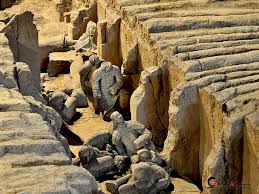
What's Inside the Terracotta Army Pit 2?
Pit 2, measuring 96 meters (315 feet) long and 84 meters (276 feet) wide, is a sight to behold. This vast chamber, part of the magnificent Terracotta Army complex, houses a diverse and meticulously arranged military force, frozen in time for over two millennia.
A Military Showcase in Four Units
Unlike the regimented ranks of Pit 1, Pit 2 presents a more dynamic and strategically organized army. The pit is divided into four distinct units, each playing a crucial role in ancient warfare:
1. The Chariot Squadron: Leading the charge is a formidable force of chariots, each pulled by four powerful horses. These chariots were the heavy tanks of their time, used to break enemy lines and sow chaos in the ranks. The charioteers, armed with bows and arrows, would rain down projectiles on the enemy.
2. The Archer Divisions: Flanking the chariots are skilled archers, arranged in a "kneeling-and-standing" formation. This clever tactic maximized their firepower, allowing for a continuous volley of arrows. Some archers are depicted in the act of drawing their bows, arrows poised for flight, showcasing the incredible realism and detail of the figures.
3. The Infantry Battalions: Forming the heart of the army are the infantrymen. These soldiers, armed with spears, swords, and halberds, stand ready to engage the enemy in close combat. Their armor and weaponry vary, suggesting different ranks and roles within the infantry.
4. The Cavalry Contingent: Adding speed and mobility to the force are the mounted cavalrymen. These warriors, astride their steeds, would have harried enemy flanks, pursued fleeing soldiers, and carried out swift flanking maneuvers.
The Realities of War: Wounded Warriors and Fallen Soldiers
Adding a poignant touch to the display are figures depicting the harsh realities of war. Among the ranks, you'll find wounded warriors, some with bandaged limbs or grimacing in pain. There are also fallen soldiers, their bodies slumped on the ground, a somber reminder of the human cost of conflict.
Q&A
1. What makes the arrangement of troops in Pit 2 unique?
Unlike the regimented rows of Pit 1, Pit 2 showcases a dynamic and strategic battle formation. The four distinct units—chariots, archers, infantry, and cavalry—are arranged to highlight their battlefield roles and interaction.
2. What weapons are the Terracotta Army figures depicted using?
The figures carry a variety of weapons reflecting ancient Chinese warfare. These include bows and arrows, spears, swords (including the distinctive curved jian), halberds, and crossbows.
3. Why are there wounded and fallen soldiers depicted in Pit 2?
The inclusion of these figures serves as a reminder of the brutality and human cost of warfare. It adds a layer of realism and complexity to the display, going beyond a simple show of military might.